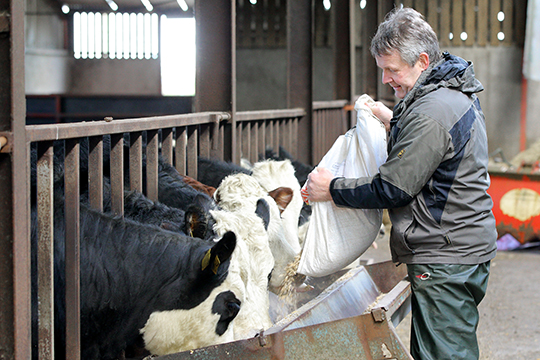Farm Safety – UFU president warns of devastating impact livestock injuries can have on farm
While it is farm deaths that attract headlines, Ulster Farmers Union president, Barclay Bell, UFU president, who has been a long-time member of the Farm Safety Partnership, warns that injuries are also serious and can have a devastating impact on farm businesses.
He says these are common place, particularly when dealing with livestock, with the gap between injury and death often uncomfortably narrow.

Mr Bell said: “As farmers we are all well used to bumps and cuts. But when those become more serious, for example broken bones or life-changing injuries, they can have a serious impact on a farm business.
“They limit the ability of a farmer to work, and that automatically puts a strain on the business and on other family members who may have to look after the farm and care for the farmer.”
Over the past ten years 17 people have been killed and many more seriously injured in accidents involving livestock.
This has prompted the Farm Safety Partnership to issue a reminder of the risks and how to minimise them. Mr Bell added: “The dangers from bulls are obvious and well known, but there have been many accidents involving recently calved cows and heifers. These are large and sometimes aggressive animals, and farmers need to be aware of the risks familiarity can bring, which often leads to complacency towards these dangers.
“As with all farm safety advice, the best approach remains to stop and think SAFE, even with everyday tasks. Those few minutes could save your life, or help avoid a serious injury that could threaten the future of your farm, and your involvement with the practicalities of running the business.”
Advice for Dealing with Livestock:
General Tips.
* Use vehicles, such as a tractor or a pick-up, when checking animals in the field, especially bulls.
* Make sure gates, races and crushes are adequate and well maintained. Never get in the race with large cattle and don’t put your arms or legs through the race bars. Only work with animals restrained in the crush.
* Always have a plan to escape. Well-designed yards should have escape points.
* Alarmed and over-excited cattle are dangerous. Give them time to settle, particularly when they’ve just been moved into the yard.
* Never underestimate the speed, power or accuracy of a kick from any cattle. Either stand well back and out of range or, when you’re working close, turn side-on and get in very close. If there’s space between you and the animal, the kick will speed up before it hits you.
* Steel-caps can prevent broken or bruised toes. Long sleeves and trousers can protect you if you’re rubbed against the rails or kicked.
Bulls
* A bull can kill you when he is being playful just as easily as when he is angry.
* If you are going to keep a bull invest in a proper bull pen.
* Bulls are more dangerous the older they get. Never trust a bull. If a bull becomes aggressive have it destroyed.
* Never turn your back on a bull.
* Avoid handling bulls alone, particularly if you are not as fast or agile as you used to be, whether through age or injury.
* If cornered by a bull, don’t move too fast. First try slowly move out of the bull’s ‘flight zone’. Turning and running invites being chased and they are usually faster. If there is no escape route, step sideways out of his best vision. This will confuse him. As a last resort, shout loudly and strike it repeatedly on the nose with your fist or a stick to make it close its eyes, then escape as fast as you can.
* If you’re trying to get a bull, or cattle, away from an injured person, make lots of noise, use your stick and don’t put yourself in harm’s way. Shout for help.
Cows and heifers with a calf
* Cows can become agitated if they feel their calves are threatened.
* The younger the calf, the more dangerous the mother. Getting between the calf and the mother without a barrier or other protection is dangerous, especially when checking or ear-tagging a new calf. A bellowing calf will agitate its mother.
* Invest in good calving facilities including pens with movable barriers and head gates to allow you to work safely and more quickly.

























